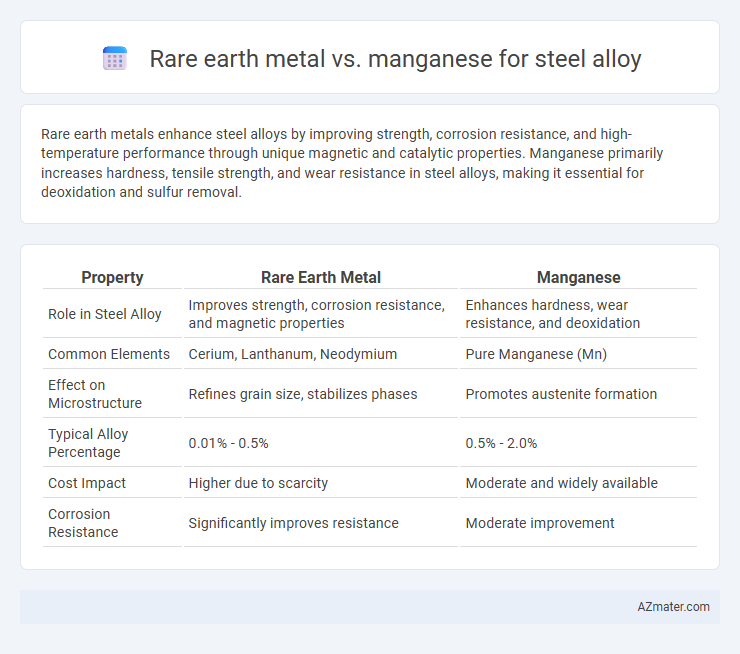Rare earth metals enhance steel alloys by improving strength, corrosion resistance, and high-temperature performance through unique magnetic and catalytic properties. Manganese primarily increases hardness, tensile strength, and wear resistance in steel alloys, making it essential for deoxidation and sulfur removal.
Table of Comparison
| Property | Rare Earth Metal | Manganese |
|---|---|---|
| Role in Steel Alloy | Improves strength, corrosion resistance, and magnetic properties | Enhances hardness, wear resistance, and deoxidation |
| Common Elements | Cerium, Lanthanum, Neodymium | Pure Manganese (Mn) |
| Effect on Microstructure | Refines grain size, stabilizes phases | Promotes austenite formation |
| Typical Alloy Percentage | 0.01% - 0.5% | 0.5% - 2.0% |
| Cost Impact | Higher due to scarcity | Moderate and widely available |
| Corrosion Resistance | Significantly improves resistance | Moderate improvement |
Introduction: The Role of Alloying Elements in Steel
Alloying elements in steel, such as rare earth metals and manganese, play crucial roles in enhancing mechanical properties and corrosion resistance. Rare earth metals improve steel's cleanliness by reducing inclusions and promoting grain refinement, leading to better toughness and durability. Manganese serves as a vital deoxidizer and strengthens steel through solid solution strengthening, increasing hardness and wear resistance essential for structural applications.
Rare Earth Metals in Steel: Properties and Benefits
Rare earth metals enhance steel alloys by improving grain refinement, oxidation resistance, and magnetic properties, which are critical for high-performance steel applications. Unlike manganese, which primarily increases hardness and tensile strength, rare earth elements like cerium and lanthanum stabilize microstructures and reduce harmful inclusions, leading to superior toughness and corrosion resistance. These benefits make rare earth metals essential for advanced steel manufacturing in aerospace, automotive, and energy sectors.
Manganese in Steel: Essential Contributions
Manganese is a critical alloying element in steel production, enhancing its strength, hardness, and wear resistance by improving the steel's microstructure and deoxidizing properties. Unlike rare earth metals, manganese stabilizes austenite and prevents the formation of brittle iron sulfides, which significantly increases toughness and fatigue resistance in steel alloys. Its affordability and abundance make manganese indispensable in manufacturing high-quality carbon and alloy steels used in construction, automotive, and heavy machinery industries.
Comparing Mechanical Properties: Rare Earth Metals vs. Manganese
Rare earth metals in steel alloys enhance mechanical properties by improving grain refinement, wear resistance, and toughness, resulting in higher strength and ductility compared to manganese. Manganese primarily increases hardness and tensile strength but can cause brittleness at high concentrations, whereas rare earth elements offer better corrosion resistance and thermal stability. Consequently, rare earth metals provide superior performance in high-stress and high-temperature steel applications compared to manganese alloys.
Impact on Steel Microstructure: Rare Earths vs. Manganese
Rare earth metals refine steel microstructure by forming stable oxides and sulfides that improve grain boundary strength and reduce inclusions, enhancing toughness and fatigue resistance. Manganese primarily acts as a deoxidizer and combines with sulfur to form MnS inclusions, which modify inclusion morphology but offer less grain refinement compared to rare earth elements. The introduction of rare earth metals results in finer, more uniform grains and cleaner microstructures, leading to superior mechanical properties than manganese alone.
Corrosion Resistance: Rare Earth Metals Versus Manganese
Rare earth metals enhance steel alloy corrosion resistance by refining grain structures and forming stable oxide layers that inhibit rust formation more effectively than manganese. Manganese primarily acts as a deoxidizer and desulfurizer but offers less pronounced improvements in corrosion resistance compared to rare earth elements like cerium and lanthanum. Incorporating rare earth metals into steel alloys results in superior durability in harsh environments due to their ability to promote finer, more protective oxide films.
Cost and Availability: Economic Factors in Alloy Selection
Rare earth metals, though enhancing steel alloy properties such as strength and corrosion resistance, often come with higher costs due to limited mining locations and complex extraction processes. Manganese, widely abundant and cheaper, remains a cost-effective alternative for steel alloy production, crucial for deoxidizing and desulfurizing steel. Economic factors heavily favor manganese in large-scale applications given its availability and lower price, despite the superior performance benefits rare earth metals may offer.
Environmental Considerations: Sustainability of Rare Earths and Manganese
Rare earth metals in steel alloys often raise sustainability concerns due to their environmentally intensive mining processes and limited global reserves, which contribute to habitat disruption and high energy consumption. Manganese, by contrast, is more abundant and widely recycled, presenting a comparatively lower environmental impact in steel manufacturing. Incorporating manganese not only supports circular economy principles but also reduces the carbon footprint associated with alloy production.
Industrial Applications: Choosing the Right Alloying Element
Rare earth metals enhance steel alloys by improving oxidation resistance, grain refinement, and magnetic properties, making them essential in high-performance applications like automotive and aerospace industries. Manganese is a critical alloying element in steel production due to its ability to increase hardness, tensile strength, and wear resistance, commonly used in construction and heavy machinery. Selecting between rare earth metals and manganese depends on specific industrial requirements such as corrosion resistance, mechanical strength, and cost-effectiveness for optimal steel alloy performance.
Future Trends: Innovations in Steel Alloying with Rare Earths and Manganese
Innovations in steel alloying highlight the increasing use of rare earth metals like cerium and lanthanum to enhance grain refinement and improve toughness, surpassing traditional manganese-based alloys in performance. Future trends emphasize combining rare earth elements with manganese to create advanced high-strength steels exhibiting superior corrosion resistance and thermal stability. Research into nano-scale alloying techniques promises to optimize the distribution of rare earth and manganese additives, driving next-generation steel materials with enhanced mechanical and magnetic properties.

Infographic: Rare earth metal vs Manganese for Steel Alloy
 azmater.com
azmater.com